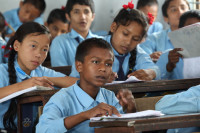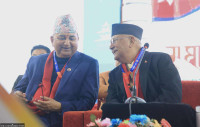Opinion
Waiting for a rainy day
Productive use of Foreign Employment Welfare Fund will go a long way in solving problems faced by migrant workers
Samik Adhikari
The Foreign Employment Welfare Fund (FEWF), created by collecting money from every outbound international labour migrant, currently has a capital base of Rs3.5 billion according to official sources. If every migrant is considered an equal shareholder in the fund, the FEWF has a paid-up capital equivalent to some of the largest banks in Nepal such as Himalayan Bank and Nabil Bank. The question then is: ?how has the government managed that money and what has been done with it?
The answer is disappointing on many counts. Yes, the government has used a fraction of the money towards important causes. For example, it has given compensation to families of migrant workers who lose their lives abroad, or provided treatment to workers who get injured. However, the Foreign Employment Promotion Board (FEPB), responsible for managing the fund, has also used itto purchase vehicles for ambassadors and dignitaries, to finance foreign trips of its officials, and even to decorate its
premises. This sort of blatant misuse of the funds, which is meant to help migrant workers toiling hard to keep their families and our economy afloat, raises important questions aboutthe funds’ management.
Skills dilemma
A small portion of the money from the fund was used to provide vocational training to around 3,500 aspiring Nepali migrants last year. While this is certainly a well-intentioned step towards creating a skilled pool of migrant workers, the actual impact of these training programmes on migrants’ skills remains uncertain.
Consider the steps taken by the migrant workers from when they decide to leave to the time before departure. On average, this process takes three to four months. Usually, a village agent helps the migrants in getting the paperwork done, puts them in touch with a recruitment agency, and helps them navigate a complex process that starts in the village and involves more than a couple of trips to major cities. By this time, the migrant, who has typically borrowed money from a moneylender in the village, is so desperate to go abroad that he tries to bypass every other bureaucratic hurdle in as little time as possible. Even the supposedly helpful and short pre-departure orientation is regarded as another burdensome formality. Hence, adding a coherent vocational training programme into that window of three to four months is like pouring rice in a sack full of holes.
Instead, one might argue that it is better if such skills training programmes target individuals who have not started the migration process. There are certainly ways to incorporate vocational and language training programmes through village development committees and local schools. But there has to be a proper assessment of the demand for such skills. The lack of Arabic language institutes in the country, even when several million Nepali migrants are in the Gulf Cooperation Council (GCC) countries, suggests that Nepali migrants do not consider knowing Arabic as an essential skill in their repertoire before departure.
Greener pastures
The Foreign Employment Act of 2007 has a special prescription on how the foreign employment welfare fund can be used. One of the provisions is about the repatriation of foreign workers upon their return. The FEPB is planning on providing livelihood support through loans to returning migrants by using the money from the fund. But that has not been implemented yet. Part of why such a scheme is not operational yet is that migration from Nepal to labour receiving countries is often circular. Migrants return home only to find a lack of investment opportunities for the capital that they bring back. Eventually, this starts another migration cycle. Therefore, although providing entrepreneurial loans to returnees is in theory an excellent idea, Nepal’s investment climate is a severe constraint for migrants willing to embark on such a venture.
One provision that is not in the Foreign Employment Act of 2007 is regarding migrant loans before departure. It is now well accepted that more than 50 percent of Nepali labour migrants borrow money from local moneylenders to finance their trip abroad. In a majority of these cases, they pay exorbitant interest rates, ranging from 30 to 60 percent. Simple calculations reveal that it takes migrants around four to six months of foreign employment just to pay off the interest on their loans. Since most migrant contracts are for two years, workers face huge opportunity costs on the money they spend to pay interest. They could instead be using that money to send their kids to school, provide healthcare for their family or invest on productive assets back home.
Now consider that a small portion of the money from the FEWF is used to provide loans for migration to the poorest of migrants. Even if they pay 15-20 percent interest rate on that loan, it frees up a significant portion of their savings abroad for productive use back home.
The government did try to encourage private banks to lend to migrants in the past without any collateral by insuring 75 percent of the default amounts. However, due to the lack of repayment enforcing mechanisms, 90 percent of the borrowers defaulted. The screening process for the scheme also suffered from nepotism and corruption.
Instead, the government should use a small portion of the money from the FEWF to subsidise private providers in conducting a pilot of a targeted migrant loan scheme without insuring any default amounts, and letthe provider figure out ways to minimise default rates. The benefit of designing a successful scheme for thousands of potential migrants outweighs any cost of a small pilot proving to be unsuccessful.
Among many reasons why Nepali migrants suffer from exploitation and abuse in destination countries is the burden of debt that they face back home. A migrant loan scheme utilising the pool of money from the FEWF has the potential to create a win-win situation for potential migrant workers and private providers. Only waiting for a rainy day to utilise the fund might lead to a scenario where FEPB officials have all the umbrellas while the migrants are the ones who get continuously drenched.
Adhikari, a graduate of Harvard University’s MPA/ID programme, is a researcher at Unicef, Nepal




 13.12°C Kathmandu
13.12°C Kathmandu










